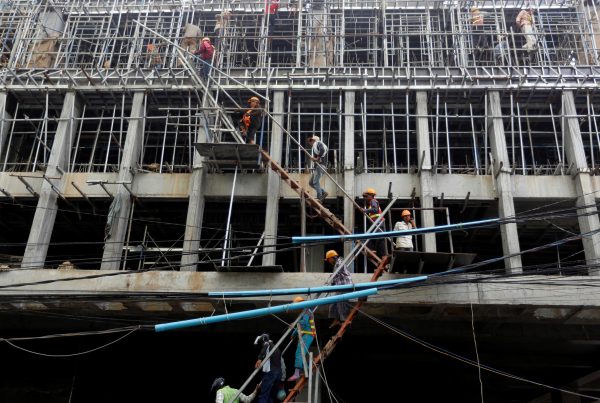Economic progress in recent years has allowed Cambodia to invest in physical and social infrastructure, attract foreign direct investment, create jobs and lift millions of its people out of poverty. The Asian Development Bank called Cambodia Asia’s new ‘tiger economy’.
Cambodia’s economic performance in 2016 remained robust, with growth continuing at 7 per cent.
Strong garment sector exports and foreign investment in construction drove this economic performance. Exports in the garment and footwear industries rose by 9.4 per cent in the first half of the year, almost double the pace in the same period of 2015 thanks to improved production processes and high demand from the European market. As of September 2016, the value of approved commercial projects in the construction sector more than doubled to US$7.2 billion. Imports of construction equipment and materials also increased to support the construction boom.
But solid growth in the industrial sector has been offset by a slowdown in agriculture and tourism. Unfavourable weather conditions and falling commodity prices have resulted in agriculture’s sluggish performance, which grew at a rate of only 0.2 per cent in 2014–2016. Tourism also underperformed in early 2016 due to a decline in tourist arrivals from Vietnam, Laos and South Korea. 1.3 million tourists visited Cambodia in the first quarter of the year, a mere 2.6 per cent increase compared to the same period in 2015.
The World Bank reclassified Cambodia in July 2016 as a lower middle-income country after its gross national income per capita reached US$1070 in 2015, surpassing the minimum threshold of a lower middle-income nation of US$1026. While this sign of progress should be welcomed, it comes with its own set of challenges. Analysts fear that this new classification will reduce Cambodia’s benefits from international foreign aid and preferential trade agreements that the country enjoyed while still a ‘least developed country’.
To prepare for the anticipated reduction in international assistance and trade privileges, Cambodia needs to strengthen its competitiveness, diversify its economy and upgrade its industries.
Although garment exports have held up well so far, the sector remains narrowly based and concentrated on a few markets, making it vulnerable to external shocks. To preserve Cambodia’s attractiveness relative to its regional competitors such as Vietnam and Bangladesh, it must diversify into higher value products and services and strengthen labour productivity to reflect the rise of the minimum wage.
The modernisation of agriculture would also help to sustain productivity in the long run. Employing more than half of Cambodia’s labour force, agriculture has contributed significantly to poverty reduction. But high reliance on rain-dependent rice production, slow adoption of quality seeds and inadequate agricultural extension services and irrigation facilities remain key constraints in the sector. Diversifying to less water intensive crops, developing the agribusiness and agro-processing industry, promoting a modernised value chain and cost effective logistics are crucial to put agriculture back on a higher growth path.
Efforts have been made so far to support economic diversification. The Cambodia Industrial Development Policy was launched in March 2015 to transform and modernise Cambodia’s industrial structure from a labour-intensive industry to a skill-driven industry by 2025. This implies increasing the GDP share of the industrial sector, diversifying goods exports including non-textiles and processed agricultural products and modernising the registration of enterprises. The policy also supports stronger regulations and enforcement and helps create a more favourable business environment.
Domestic investors also have an important role to play in the diversification process. Experts believe that the success of Cambodia’s economy will be driven by local entrepreneurs and the private sector, not by international donor assistance. Providing support to domestic investors in trade facilitation, logistics, infrastructure and human capital is just as important.
Cambodia faces many challenges to stay competitive. To realise its vision of becoming an upper middle-income country by 2030 requires strong commitments to address infrastructure bottlenecks, build a high-quality human capital base, strengthen natural resource management, enhance governance and improve financial services and the business environment.
Heng Pheakdey is the founder and chairman of Enrich Institute.
This article is part of an EAF special feature series on 2016 in review and the year ahead.

